8 Best Markdown Note-Taking Apps for 2025
Best Markdown Notetaking Apps
11th Dec, 2024
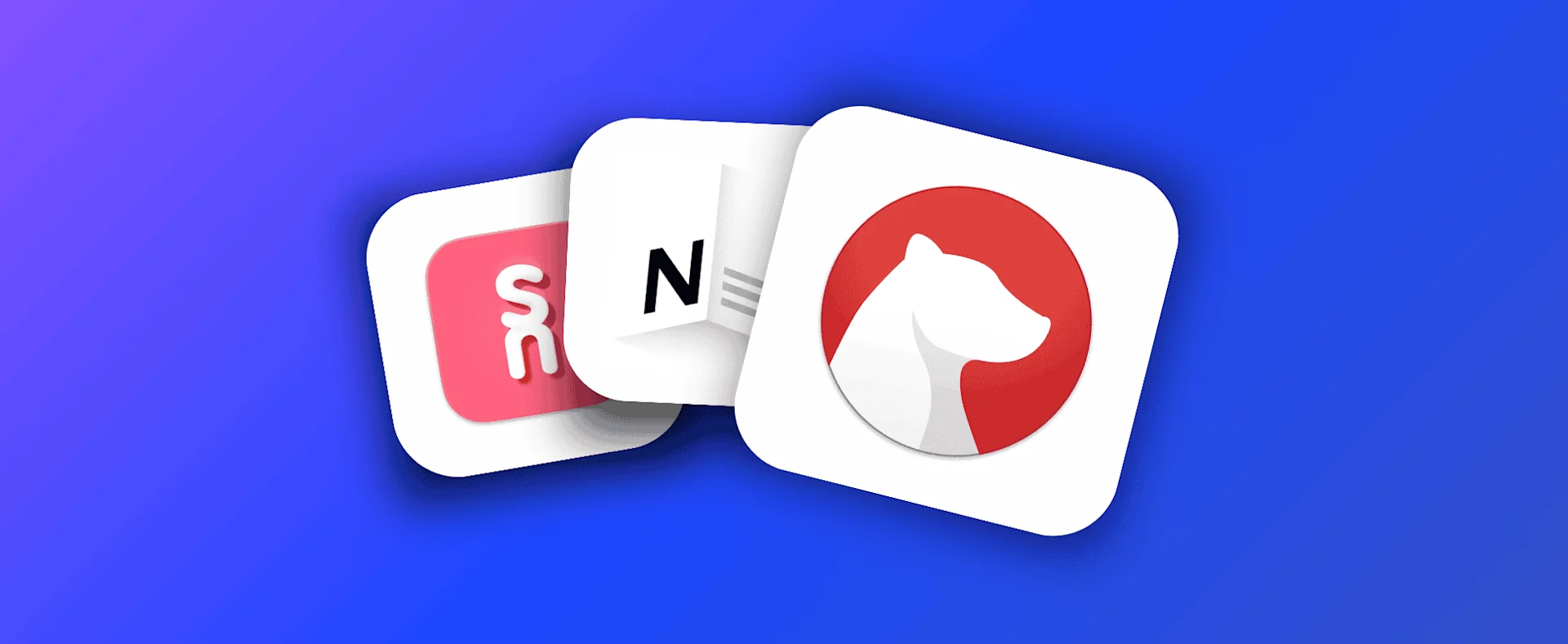
Markdown note-taking apps help you to better take notes for more markdown rich note-takers. Here's our best markdown note-taking apps and why they are special for those who have learnt or embraced markdown.
Maybe you worry about your note-taking app shutting down.
Or perhaps you've recently learned markdown and want to show off your writing speed?
Whatever your goal, markdown notes can help be more portable, easy to replicate, and perfect for those who want to be more raw with their note-taking. While learning syntax and basics might take some time, it can open up more note-taking apps you can switch between and customize to your liking.
You might also have been recommended to try Markdown for your note-taking and research the options out there; if that's you, let's start with some of the basics of Markdown to help you get caught up.
What is markdown note-taking?
Markdown note-taking refers to the use of a lightweight markup language.
Markdown allows you to format text using plain text syntax, which is simpler and more intuitive than more complex HTML or rich-text formatting. This note-taking method is particularly popular among those who prefer a clean, distraction-free environment for writing and organizing thoughts. Many apps adapt to this style.
What makes a good markdown note-taking app?
Many millions use and learn markdown as we speak; here's why:
- Lightweight: The note-taking app should be quick and responsive, especially for markdown functionality.
- Easy to use & simplicity: Simplicity outside markdown is crucial for long-term usability.
- Focused experience: A clean UX enhances note management and keeps the experience streamlined.
8 Best Markdown Note-Taking Apps
Here are all our top recommendations for you:
1. Bear Notes
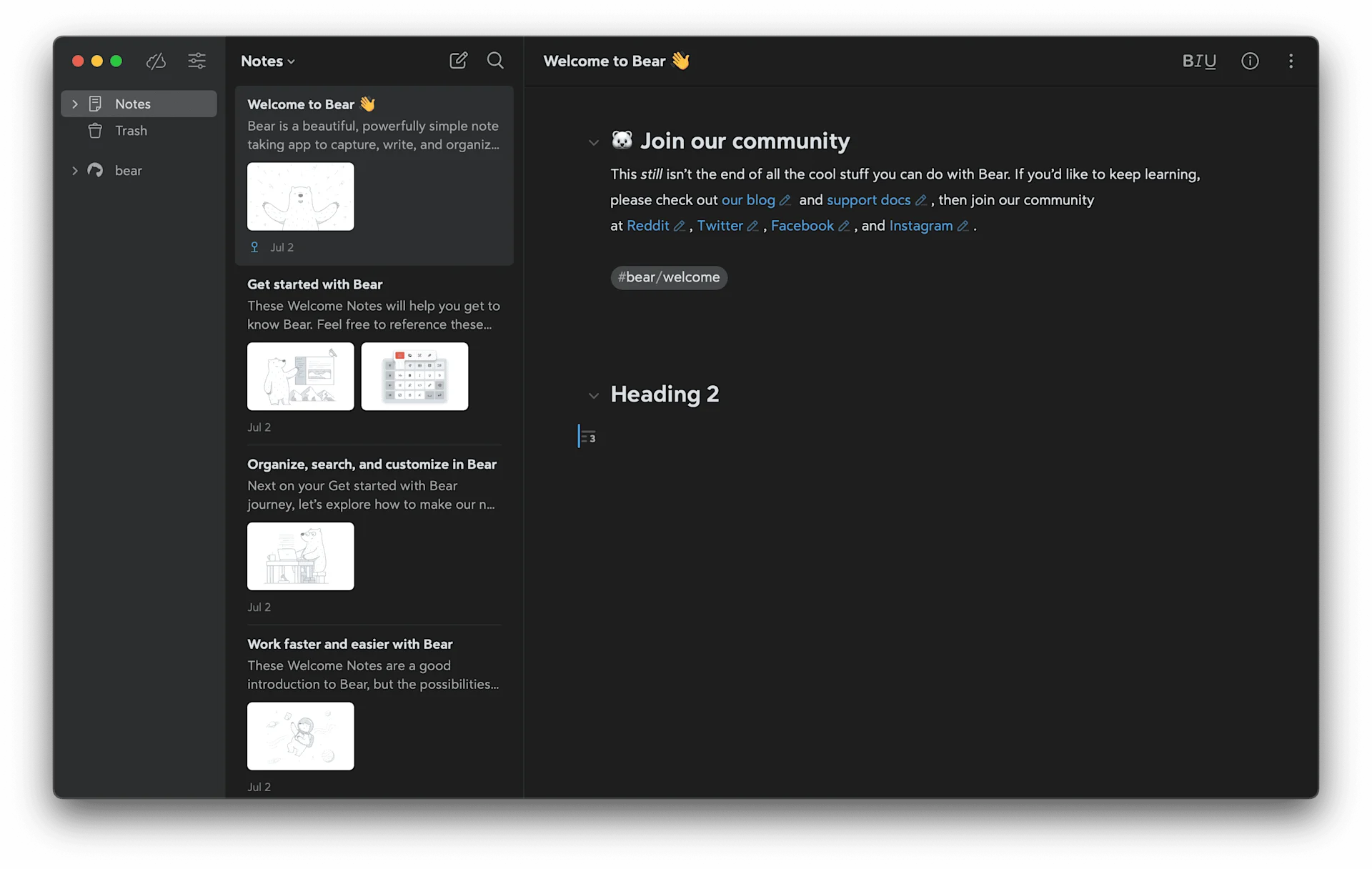
Bear Notes is available on Mac, iPhone, and iPad. It's a popular markdown note-taking application on iOS devices, loved by many for its features, including checkboxes, tables, images, and sketching. People appreciate Bear Notes's minimalistic nature and lightweight experience, making it feel less like a typical markdown editing experience. You can switch between modes and still use the core language inside the editor.
It also offers excellent features such as backlinks and a table of contents and supports multiple languages within its more prevalent pricing. Export options include PDF, HTML, DOC, JPEG, and more, along with OCR, adding extra power to your markdown notes.
Best Markdown features in Bear Notes:
- Basic formatting with headings, format, and lists
- Code blocks for code snippets
- Connects with links and footnotes
- Bear Notes lacks abilities with Math Support.
Pros:
- Comes with a markdown editor
- Reasonable pricing per year
- Easy to use for all types of note-takers
- Well-developer and respected developer
- Bunch of themes and app icons to customize
Cons:
- It might be too basic for some
- Limited to iOS and macOS devices
Pricing:
Bear Notes is priced at $29.99 per year for the premium experience.
2. NotePlan
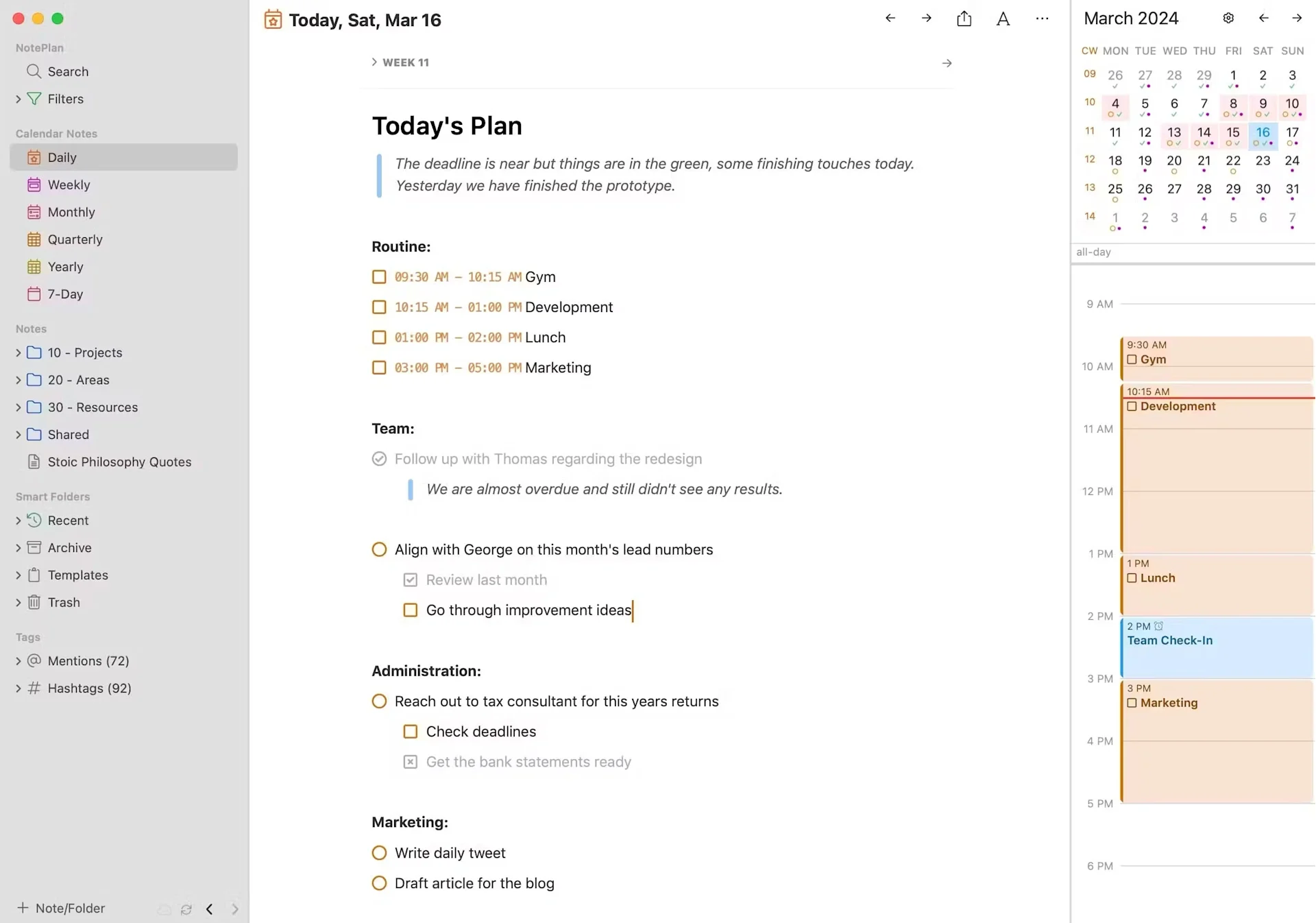
NotePlan is a popular option for combining tasks, notes, and calendars, going further than apps like Agenda. It recently added a new version. It allows you to add markdown tasks, which are popular with the bullet journaling community, as it combines their concepts with notes and calendars in one location. People like it for daily note-taking and managing yearly, weekly, and monthly notes.
Features include PKM and filtering, which improve task management and time blocking. The markdown feature is handy for on-the-go use, ensuring notes are safe, secure, and quickly accessible.
Pros
- Combines tasks, notes & calendars in one
- Fast and robust app for Apple-focused devices
- Perfect for those with date-based notes
- Works well with templates
- Popular for bullet journal lovers
Cons
- Pricier yearly option with no free
Pricing:
- NotePlan charges $99.99 per year with no free plan.
3. Agenda Notes
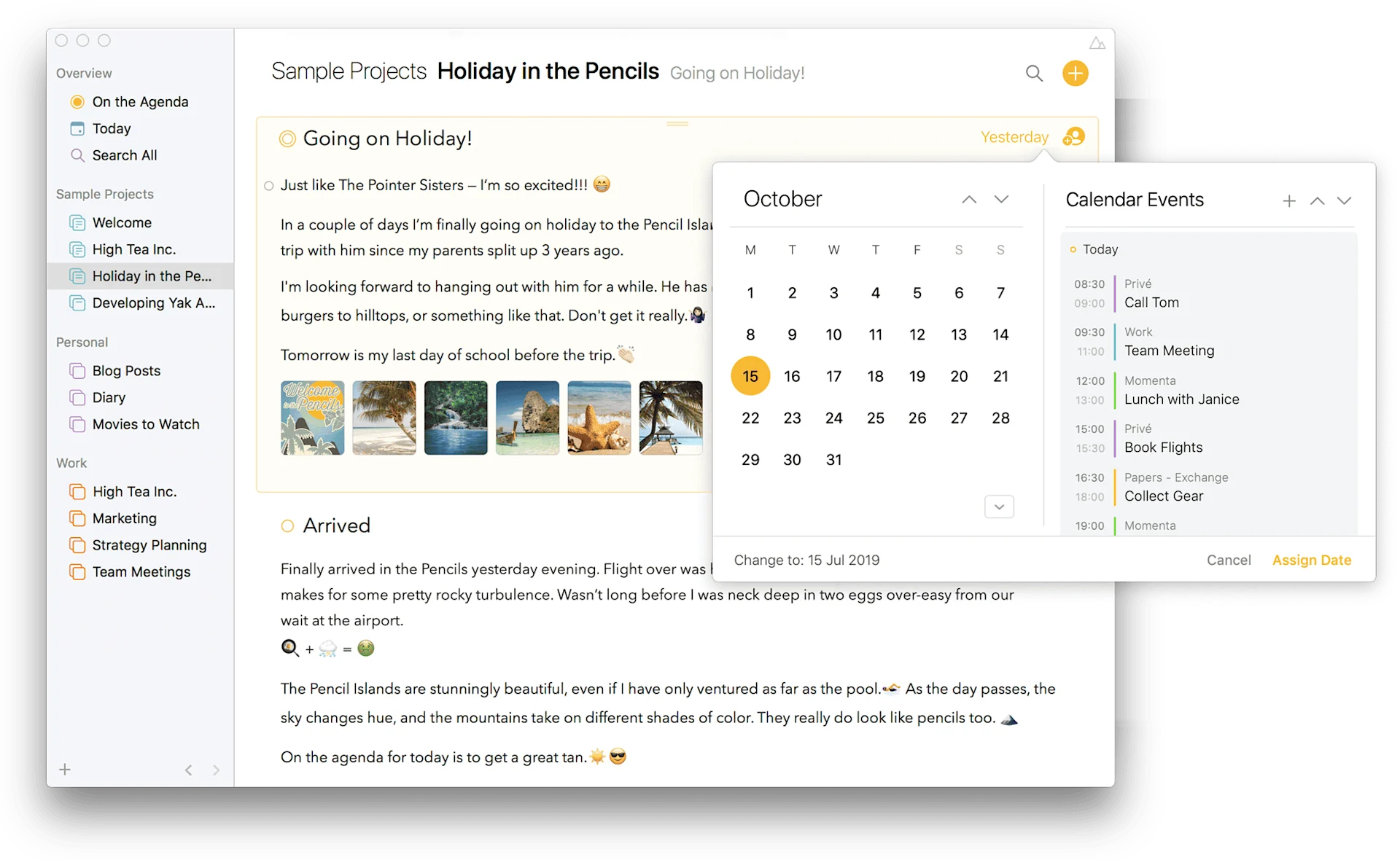
Agenda is a markdown application integrated with a calendar, allowing you to manage your next meeting, plan a holiday, or coordinate an upcoming date. People like this concept, especially when it syncs with their calendar within the note-taking application at one location. This setup is perfect for journaling, planning team meetings, or even delivering a speech at a wedding.
The combination of features allows the use of markdown across all notes linked to dates. Users typically love Agenda for its ability to plan, making it ideal for coordinating their calendars and integrating them with their accounts.
Pros
- Great for those with calendar-focused notes
- Perfect for iOS and macOS users
- It comes with a good free with option to upgrade
- Attractive to use and look at for notes
- Works with markdown
Cons:
- It can be pricier if you go with a premium
Pricing:
Agenda Notes is 139 EUR per 12 months. Agenda Notes is free to use.
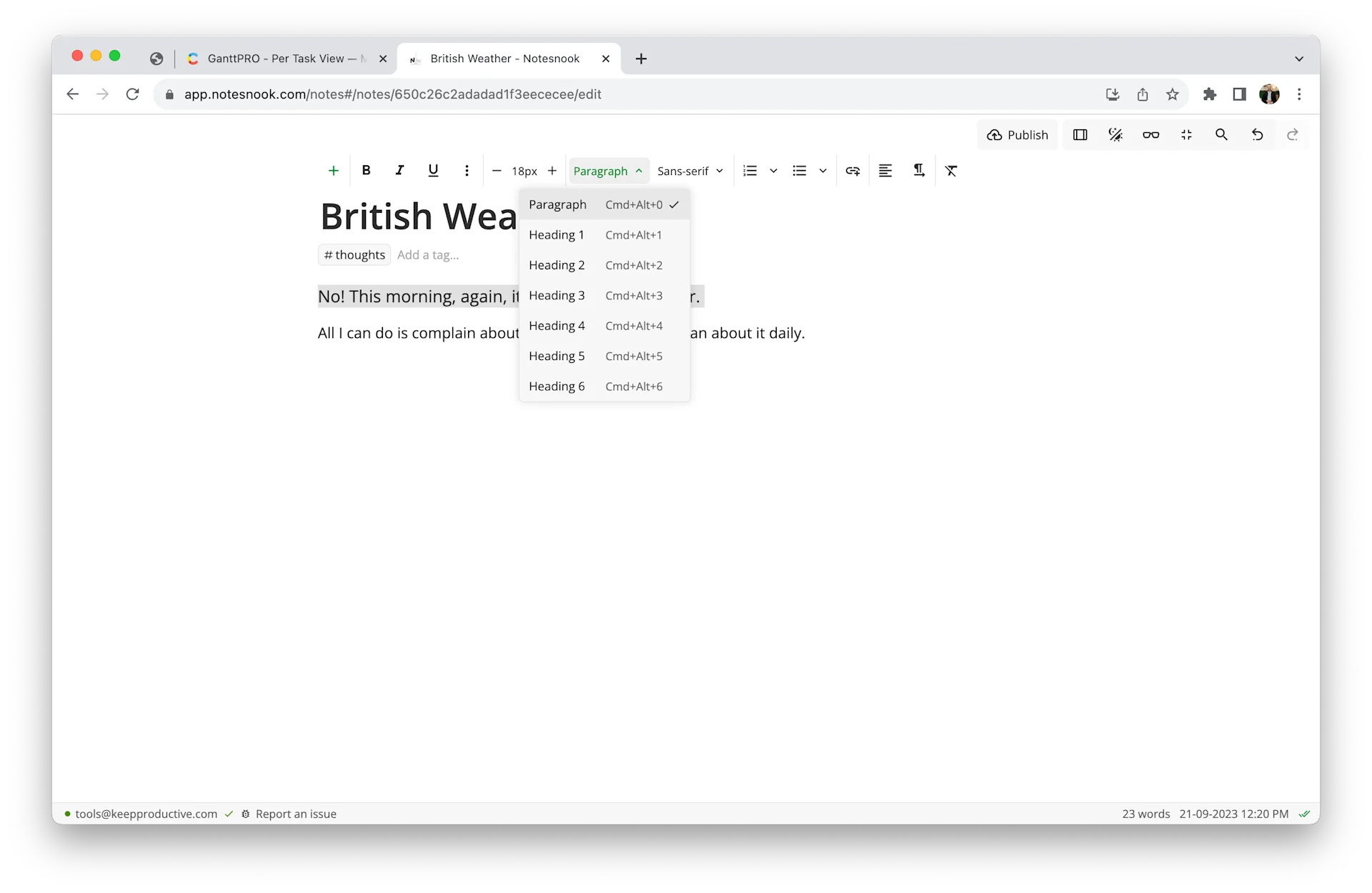
4. Notesnook
Notesnook is a secure, focused note-taking application that focuses on notes that are privacy-first in nature. This allows notes to be secured under E2E that makes for safer notes, this can be enhanced by the Notesnook premium pricing which extends that even further much like software like Standard Notes.
Notesnook has good markdown abilities, which extend to the reminders feature, which can be activated in premium. It allows for markdown shortcuts like "slash date," "slash time," and "slash now," which connect to that feature. Notesnook makes for a secure markdown option in this list.
Pros
- Focus on security and note-taking
- Can be a perfect hub for note-taking
- Range of formats for notes
Cons
- Not the most attractive design & look
- Comes with slow releases of features
5. Supernotes
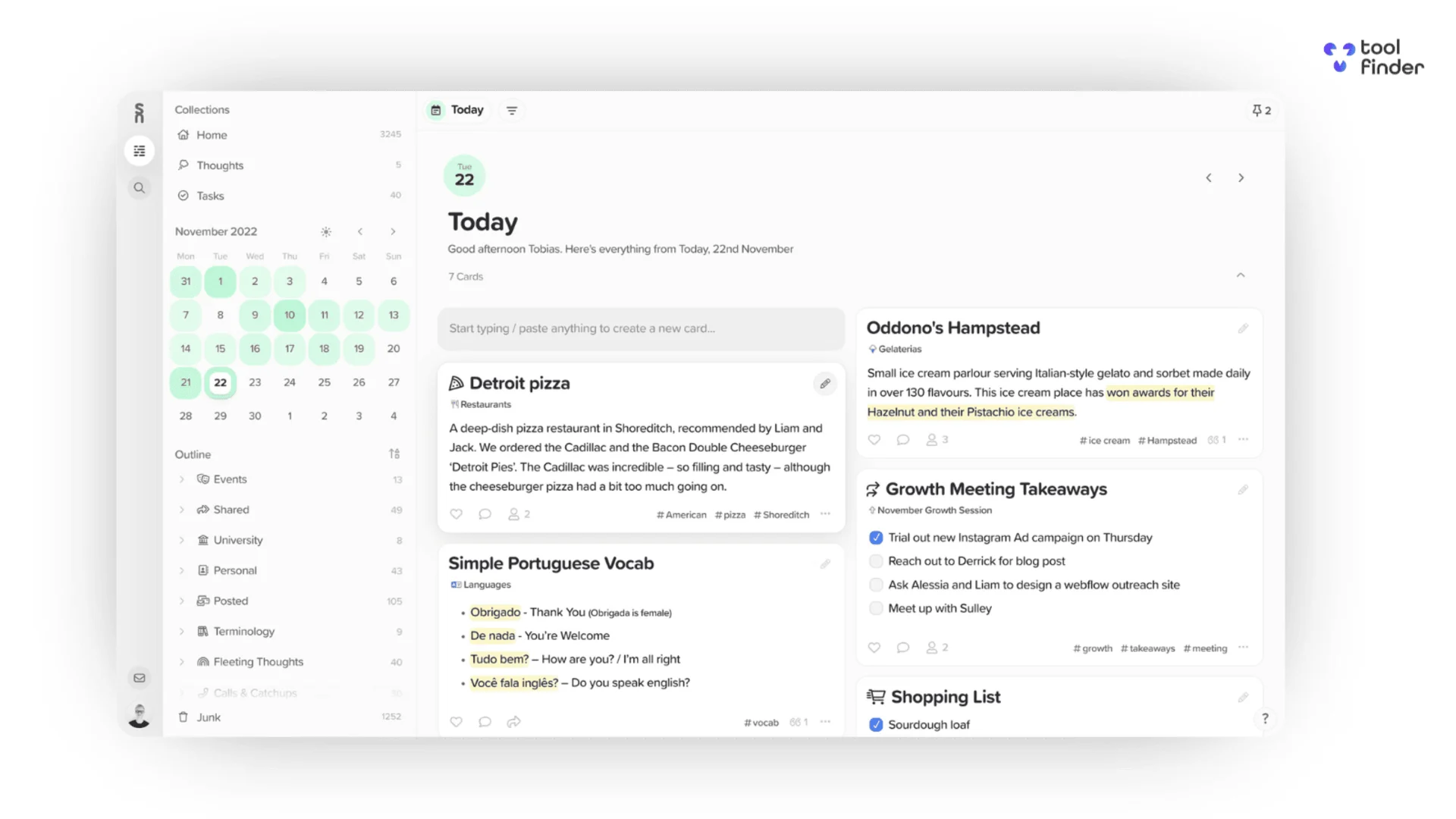
Supernotes uses markdown language to make notes. What makes Supernotes appealing is its clean, intuitive interface. As you type using Markdown, the app instantly transforms your plain text into an organized structure. This is particularly handy for those who prefer a minimalist approach but still want the power of Markdown at their fingertips. The app's focus on collaboration is a big plus, making it easy to share and work on notes with others.
It's a solid choice for those who need a straightforward, no-frills markdown editor that supports teamwork and sharing. Ideal for students, small teams taking notes, or anyone looking for an efficient way to manage notes and ideas, Supernotes offers a blend of simplicity and collaboration that’s quite appealing in the markdown notes app space.
Pros
- Security-focused
- Offline and fast-loading notes
- Comes with all apps (including Linux)
- Independently developed tool
- Premium pricing isn't crazy
Cons
- The free plan limits you to 100 notes.
- Can be overly complicated for some people
Pricing:
Supernotes are free for up to 100 cards but charge $7.61 per month for premium.
6. Obsidian

Obsidian is built perfectly to take notes in markdown. Markdown in Obsidian is like a secret weapon for your notes. It's all about using simple symbols to format text - think of it as shorthand to make your notes look good without the fuss. Need to highlight something important? Just wrap it in ** or __ and it becomes bold. It's that straightforward.
While you jot down your notes using markdown syntax, the app shows you a live preview. It's like having a real-time translator turning your plain text into neatly formatted notes. This feature is a game-changer for visual learners who want to see the end result as they type. Obsidian’s linking feature is fantastic for connecting ideas across notes, turning your notes into a personal knowledge base. Inside each note, you can preview it in or out of Markdown, and there are a range of settings to help you view it, including how HTML is imported to Markdown.
Best Markdown features for Obsidian:
Obsidian offers good offerings for those wanting to go harder on markdown with the basic formatting markdown and options for the following. Tables
- Code blocks
- Block quotes
- Math & diagrams
Pros:
- Comes with PKM abilities
- Powerful graph view for networked notes
- Obsidian adds new features fairly regularly
- You can switch on and off features
- Free & easy access
Cons:
- Lacks project management
- Does not have database abilities
Pricing:
Obsidian is free to use with no limits; there is a $4 per month pricing for E2E notes & sync.
7. Notable
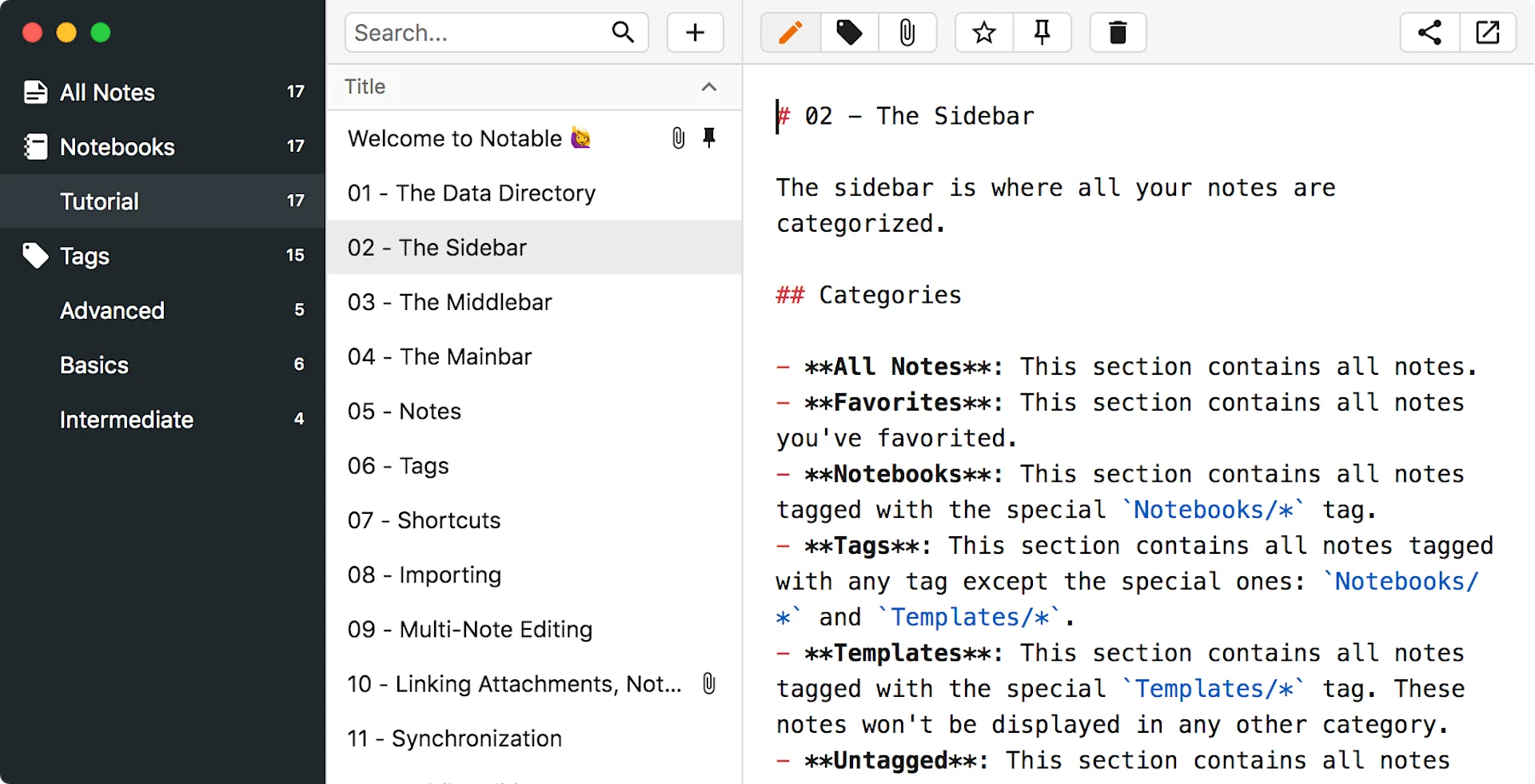
Notable markets itself as a markdown note-taking tool and is free, too. It comes with a Markdown editor with a cheat sheet, perfect for beginners who want to get used to it. Those not used to Markdown won't be able to switch to an edit-like view without seeing Markdown, so it's perfect for hardcore users.
It has features like multi-cursors, line numbers, a minimap, and scrolling beyond the last line, which make it easier for people to manage their markdown notes. It also works as a local-first note-taking app stored on a device, which is better for security, something many PKM note-taking apps typically do.
8. Simplenote
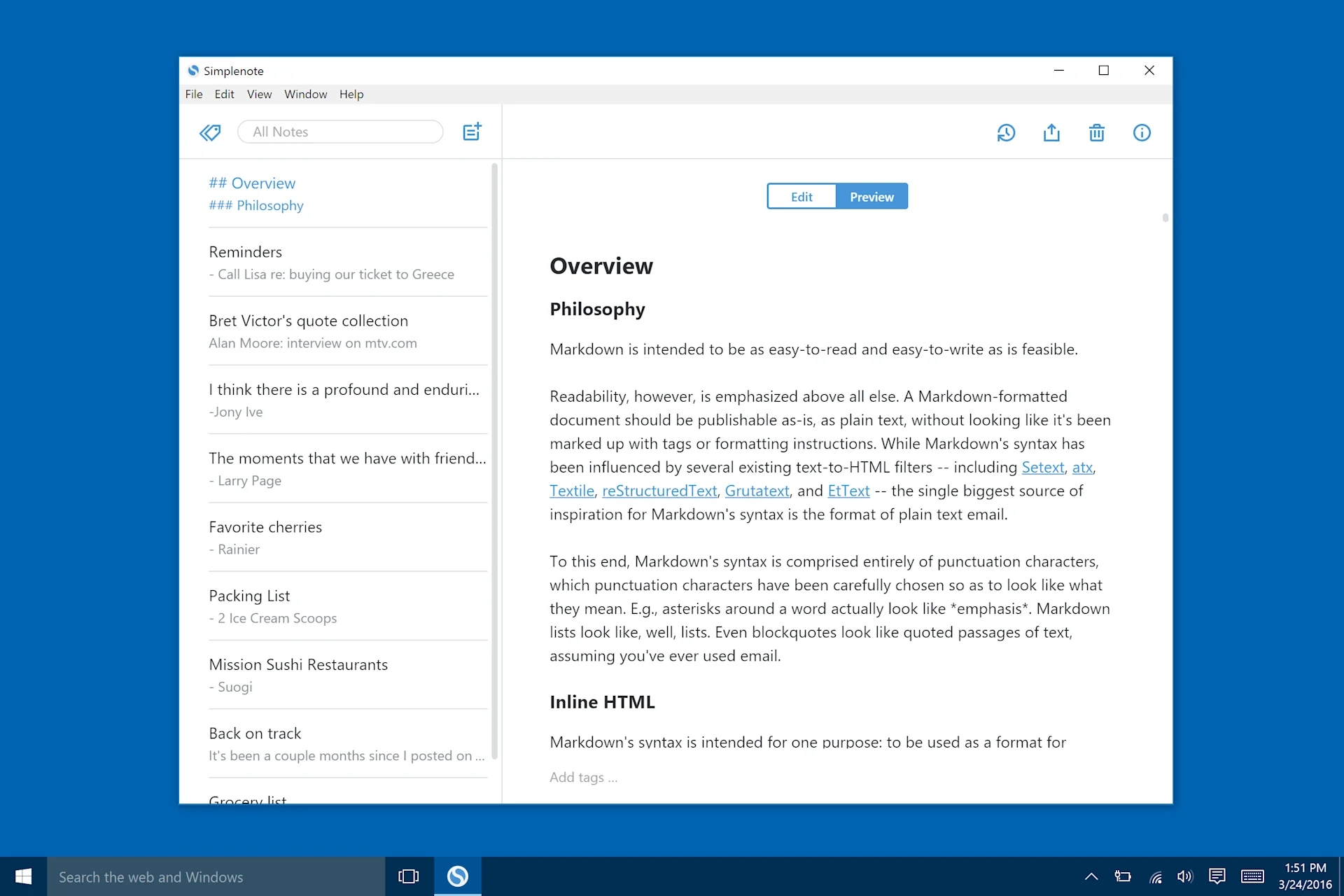
Simplenote is an easy-to-use markdown note-taking app developed by the folks at Automattic, the same people making WordPress, and it offers a free and easy-to-use markdown experience for managing notes. The main factor out of all the markdown note-taking apps is that it is free to use and come with some basic but easy-to-handle features.
Pros:
- Easy to use
- It comes with a simple design
- Works with markdown
Cons:
- It can be underwhelming to look at
- Lacks media and power features
Pricing:
Simplenote is free to use with optional premium subscriptions.
9. Inkdrop
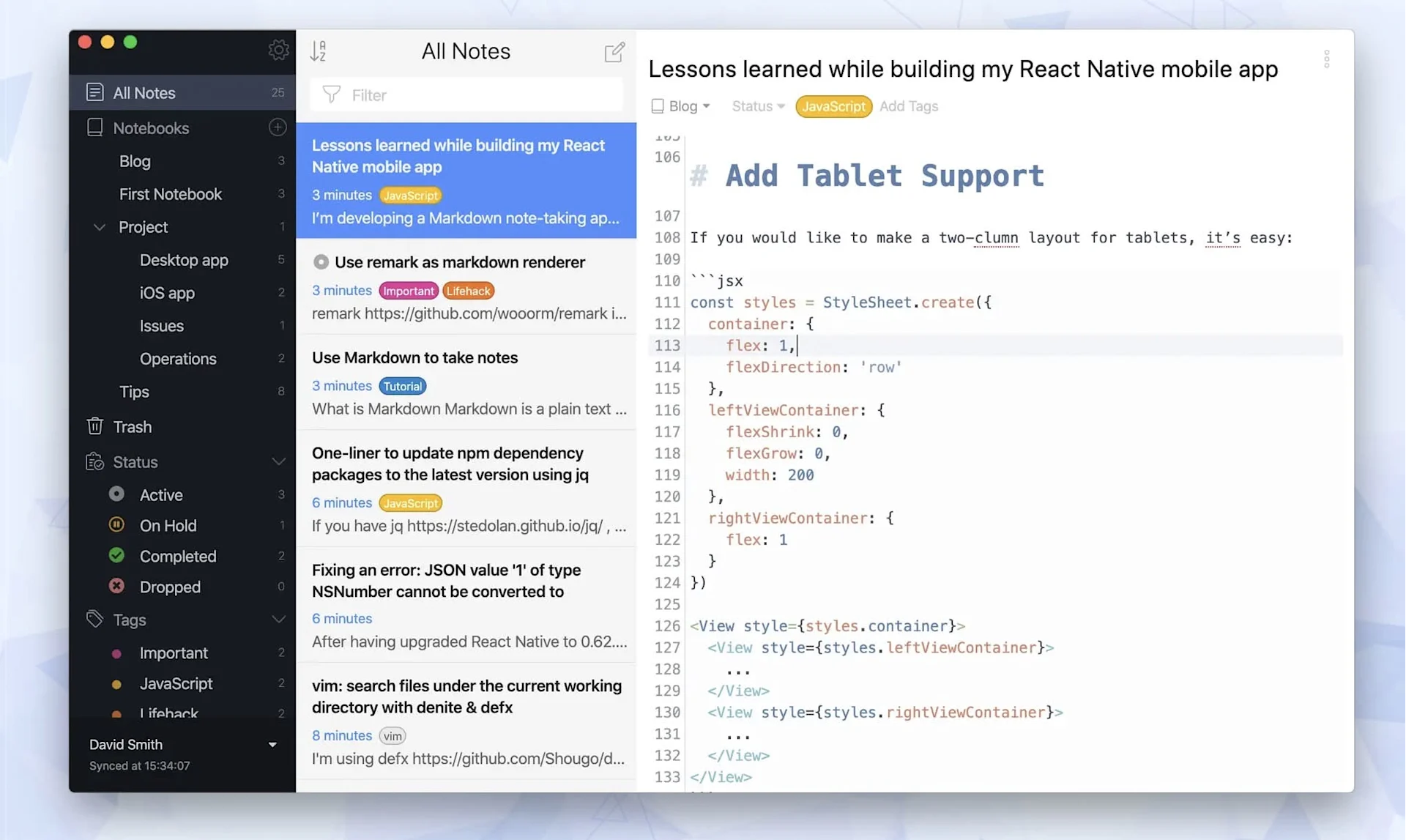
Inkdrop is an easy-to-use markdown editor popular with those in tech and development for managing markdown notes. It runs with Javascript and code editing. Encrypted and cross-platform, making it one of the only markdown note-taking apps available on all devices - including Mac, Windows & Linux with mobile apps too.
Pros:
- Comes on all devices
- Works on mobile too
- Good for developers
Cons:
- Many people might not need it to be this complex
Pricing:
Inkdrop is not free; it comes with a $9.98 per month pricing.
Oops, undefined is still in development...
Weekly Roundup: Explore People's Productivity Tools
Become a reader to our newsletter exploring what productivity apps people use on a daily basis to get things done